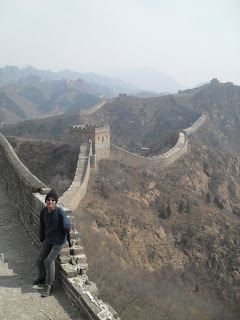

Beijing, China’s capital since the Yuan Dynasty (about 800 years ago), is one of the world’s most fascinating cities. It combines both old and new on a grand scale. Beijing has its traditions, but it is also leaping ahead into a world-class metropolis.
I came to Beijing primarily to witness its history. The top four historical sites that cannot be missed are the Forbidden City, Summer Palace, Temple of Heaven and Great Wall. The Forbidden City, next to the famous Tiananmen Square, was China’s seat of royalty during the Ming and Qing dynasties. The gigantic complex contains a garden and many halls and residences with orange tiled Chinese roofs and red columns. I found the architecture not quite fascinating, as I grew up with Chinese architecture. The Summer Palace, on the other hand, was the emperor’s suburban residence. The complex contains a huge lake, Kunming, with several bridges, pagodas and a temple complex on a hill. The Summer Palace is a great escape from the city’s crowds. The Temple of Heaven is where the emperor would pray for a good harvest. This complex contains the famous Harvest Prayer Hall, with its three-storied round structures.
The Great Wall, the only man-made structure seen from space, is my favorite historical structure. Together with a group of CouchSurfers, we took a two-hour van to the outskirts of Beijing. We then proceeded on a 10km hike from Jinshanling to Simatai, which took about 5.5 hours. The hike was phenomenal! Not only were there few tourists, but I could see the wall snake its way up and down the hills for miles. It was amazing to trod on a historical path and appreciate the work that was put into building this masterpiece.
I came to Beijing primarily to witness its history. The top four historical sites that cannot be missed are the Forbidden City, Summer Palace, Temple of Heaven and Great Wall. The Forbidden City, next to the famous Tiananmen Square, was China’s seat of royalty during the Ming and Qing dynasties. The gigantic complex contains a garden and many halls and residences with orange tiled Chinese roofs and red columns. I found the architecture not quite fascinating, as I grew up with Chinese architecture. The Summer Palace, on the other hand, was the emperor’s suburban residence. The complex contains a huge lake, Kunming, with several bridges, pagodas and a temple complex on a hill. The Summer Palace is a great escape from the city’s crowds. The Temple of Heaven is where the emperor would pray for a good harvest. This complex contains the famous Harvest Prayer Hall, with its three-storied round structures.
The Great Wall, the only man-made structure seen from space, is my favorite historical structure. Together with a group of CouchSurfers, we took a two-hour van to the outskirts of Beijing. We then proceeded on a 10km hike from Jinshanling to Simatai, which took about 5.5 hours. The hike was phenomenal! Not only were there few tourists, but I could see the wall snake its way up and down the hills for miles. It was amazing to trod on a historical path and appreciate the work that was put into building this masterpiece.
Modern Beijing is undeniably spectacular. I started off my tour visiting the National Grand Theatre, in the shape of an egg “floating” in a pool of water. I then visited Olympic Park, site of the successful 2008 Beijing Olympic Games. Of particular interest to me was the National Stadium (“Bird’s Nest”) and the National Aquatic Centre (“Water Cube”). The other part of modern Beijing are the malls and shopping districts that have cropped up these past few years. There are probably more foreign brand-name outlets in Beijing now than in Hong Kong. Areas such as Wangfujing Dajie and Sanlitun are about as capitalistic one will find in China.
One part of Beijing that I enjoyed was the area of Houhai, with its renovated hutong (alleys). In recent years, the city has begun to realize the tourism potential of its historical buildings and have converted many stone courtyard homes into bars, cafes and restaurants. Many of these homes are simply charming.
Dining in Beijing. All I can say is “yum!” This is because as China’s capital, Beijing has all types of Chinese food. In fact, one hardly even knows what Beijing food is, except of course, for the famous Peking duck. I was fortunate enough to dine on Peking duck (my favorite part is the sweet plum sauce) with Cser Calvin at the most famous place of all, Quanjude. My other dining adventures in Beijing involved munching on bao zi (steamed buns with pork and vegetables), jiao zi (soup dumplings) and bing (crepe with egg and onions).




That thing about the Great Wall being the only man-made object visible from space is an urban legend. See
ReplyDeletehttp://www.snopes.com/science/greatwall.asp